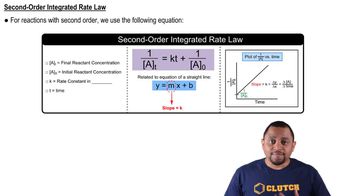Here are the essential concepts you must grasp in order to answer the question correctly.
Second-Order Reactions
A second-order reaction is one where the rate of reaction is proportional to the square of the concentration of one reactant or to the product of the concentrations of two reactants. For a reaction of the form A → products, the rate law can be expressed as rate = k[A]^2. This means that as the concentration of A decreases, the rate of reaction also decreases, which is crucial for calculating concentration changes over time.
Recommended video:
Integrated Rate Law
The integrated rate law for a second-order reaction provides a relationship between concentration and time. It is given by the equation 1/[A] = 1/[A0] + kt, where [A] is the concentration at time t, [A0] is the initial concentration, k is the rate constant, and t is the time elapsed. This equation allows us to calculate the concentration of a reactant after a specific time period.
Recommended video:
Units of Rate Constant
The units of the rate constant (k) are essential for ensuring dimensional consistency in rate equations. For a second-order reaction, the units of k are M^-1 s^-1, indicating that the rate of reaction depends on the concentration squared. Understanding these units helps in correctly applying the integrated rate law and interpreting the results of concentration calculations over time.
Recommended video:
 Verified step by step guidance
Verified step by step guidance

